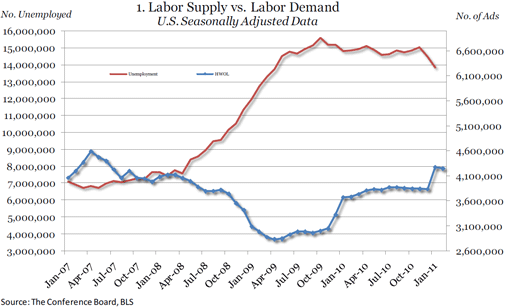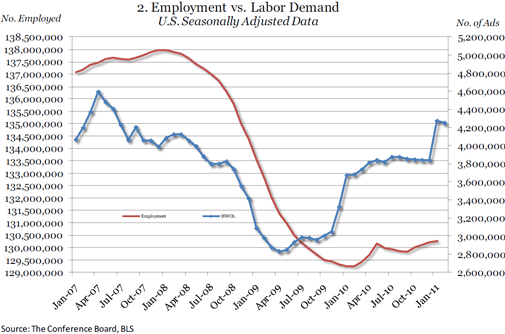

REGIONAL AND STATE HIGHLIGHTS
- Supply/Demand drops to just over three unemployed for every advertised vacancy
Labor demand dipped 16,300 in the South in February. Among the larger States in the region, Maryland posted an increase of 16,600 and Georgia had a slight increase of 2,300. The increases were offset by dips in several States including Texas (-14,400), Virginia (-8,000), Florida (-1,300), and North Carolina (-700). Among the less populous States in the South, Oklahoma fell 4,000, South Carolina declined by 3,600, West Virginia was down 2,000, and Arkansas edged down 1,600.
In February, the Midwest slipped by 10,800 with States posting modest losses and gains. Ohio led the region with its gain of 8,600. Michigan and Minnesota followed with gains of 5,900 and 2,400 respectively while Illinois posted a decline of 7,100. Among the larger States, Missouri and Wisconsin fell 6,000 and 4,700 respectively. Among the States with smaller populations, Iowa declined by 3,800, Indiana shrank by 2,800, and Kansas slipped by 1,800, while North Dakota and South Dakota edged down by 1,700 and 1,300 respectively.
The West was the only region to post a gain this month, up 2,400; it was led by California’s gain of 6,400. Along the West Coast, Washington State rose 3,900 in February as Oregon slipped by 2,200. Among the largest Mountain States, Colorado rose 3,100 while Arizona remained stable. Some of the less populous States posting decreases included Utah, New Mexico, and Montana, which declined by 3,300, 1,500, and 1,300 respectively.
The Northeast was basically unchanged (down 700) in February. New York and Massachusetts both rose 2,700. New Jersey dropped 9,300 this month. Pennsylvania posted a 2,000 loss in February. Among the smaller States in New England, Connecticut rose 5,000 while Maine, Vermont, and New Hampshire were down by slim margins: 700, 400, and 300 respectively. Rhode Island remained basically unchanged (adding 200).
The Supply/Demand rate for the U.S. in January (the latest month for which unemployment numbers are available) stands at 3.24, indicating that there are over 3 unemployed workers for every online advertised vacancy. Nationally, there are 9.6 million more unemployed workers than advertised vacancies. January unemployment data for States will not be available until later in March. Looking at the December 2010 data, the States where there were fewer than two unemployed for every advertised vacancy included North Dakota and South Dakota (Supply/Demand rates of 1.14 and 1.66 respectively) as well as Nebraska (1.77) and Alaska (1.96). The State with the highest Supply/Demand rate is Mississippi (7.84), where there are almost 8 unemployed workers for every online advertised vacancy. There are a number of States in which there are over five unemployed for every advertised vacancy including Kentucky (5.84), Michigan (5.65), Indiana (5.30), South Carolina (5.19), Alabama (5.17), Florida (5.12), and California and Nevada (both with Supply/Demand rates of 5.09).
It should be noted that the Supply/Demand rate only provides a measure of relative tightness of the individual State labor markets and does not suggest that the occupations of the unemployed directly align with the occupations of the advertised vacancies (see Occupational Highlights section).
OCCUPATIONAL HIGHLIGHTS
Labor demand in February:
- Demand for workers in Computer and Mathematical, Sales and Transportation and Material moving occupations rose in February
Among the top 10 occupation groups with the largest numbers of online advertised vacancies, labor demand for Computer and Science workers increased by 9,500 in February to 584,800, led by a demand for computer systems analysts, web developers, and computer software engineers (applications). Job opportunities remain favorable in this occupational category with slightly over 3 ads for every job-seeker (S/D of 0.29).
In February, Sales and Related occupations posted a gain of 6,800 to 561,000. In Sales and Related there are almost 3 (2.71) unemployed workers for every advertised vacancy. At the same time Management positions rose by 4,900 to 444,800. Management positions that had the largest increase in advertised vacancies included marketing managers, sales managers, medical and health services managers, and financial managers. The S/D rate in Management is under 2 (1.59) unemployed workers for every advertised vacancy.
Business and Financial Operations positions decreased by 6,400 to 246,200 advertised vacancies in February. Accountants, management analysts, and financial analysts were among the advertised vacancies that showed declines. In the field of business and financial operations there are almost 2 unemployed workers for every advertised vacancy. Advertised vacancies in Architecture and Engineering jobs fell by 5,200 to 161,400. In Architecture and Engineering there is roughly one unemployed worker for every advertised vacancy. (S/D of 0.89)
Labor demand for Healthcare Practitioners and Technical occupations dropped 4,300 in February to 600,100. The drop largely reflected decreases in advertised vacancies for registered nurses and occupational and physical therapists. Healthcare Support positions posted a similar decrease of 4,200 to 139,000 in February.
Healthcare is a broad field, and the relative tightness of the labor market varies substantially from the higher-paying practitioner and technical jobs to the lower-paying support occupations. In January, the latest month for which unemployment data are available, advertised vacancies for healthcare practitioners or technical occupations outnumbered the unemployed looking for work in this field by over 3 to 1, and the average wage in these occupations is $33.51/hour. In sharp contrast, the average wage for healthcare support occupations is $12.84/hour and there were about 2 unemployed looking for work in the field for every advertised vacancy.
METRO AREA HIGHLIGHTS
- Washington, D.C., Honolulu, and Milwaukee have the lowest Supply/Demand rates
In February, 51 of the 52 metropolitan areas for which data are reported separately posted over-the-year increases in the number of online advertised vacancies. Salt Lake City, Utah dipped by 1,400 to 19,300. Among the three metro areas with the largest numbers of advertised vacancies, the New York metro area was 16.8 percent above its February 2010 level, the Los Angeles metro area was 20.9 percent above its February 2010 level, and the Washington D.C. metro area was 12.9 percent above last year’s level.
The number of unemployed exceeded the number of advertised vacancies in all of the 52 metro areas for which information is reported separately. Washington, DC continues to have the most favorable Supply/Demand rate (1.24) with the number of unemployed slightly more than the number of advertised vacancies. Honolulu, Milwaukee, Boston, and Minneapolis-St. Paul were metropolitan locations where there were approximately two unemployed looking for work for every advertised vacancy. On the other hand, metro areas in which the respective number of unemployed is substantially above the number of online advertised vacancies include Riverside, CA — where there are over 11 unemployed people for every advertised vacancy (11.17) — Sacramento (6.65), Miami (6.57), and Las Vegas (5.88). Supply/Demand rate data are for December 2010, the latest month for which unemployment data for local areas are available.





